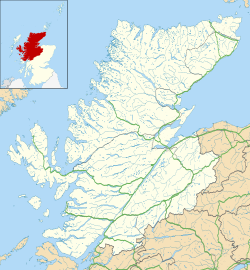History of Ardvreck
The castle was built in the 15th century by the MacLeods of Assynt. It replaced Assynt Castle which was four miles (six kilometres) northwest of Inchnadamph. [1]
Ardvreck is notable as the place where the royalist James Graham, 1st Marquess of Montrose was handed over in 1650 to the Covenanter forces by MacLeod, Laird of Assynt after the Battle of Carbisdale. [1] The true history of this event is unclear. One account is that MacLeod, loyal to the Covenanters, arrested the weary, fleeing, Montrose and held him. Another is that he provided comfortable shelter, but betrayed Montrose for a £25,000 reward. [2] [3]
Clan Mackenzie attacked and captured Ardvreck Castle in 1672, [1] and then took control of the Assynt lands. In 1726 they constructed a more modern manor house nearby, Calda House which takes its name from the Calda burn beside which it stands. A fire destroyed the house in 1737 and both Calda House and Ardvreck Castle stand as ruins today. [4] They are designated as scheduled monuments. [5] [6]
- Ardvreck on a misty day in July 2024
This page is based on this
Wikipedia article Text is available under the
CC BY-SA 4.0 license; additional terms may apply.
Images, videos and audio are available under their respective licenses.









